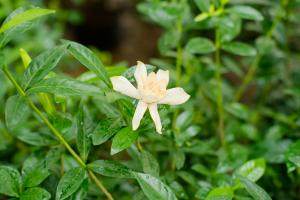Raise flowers in the sand, and the rotten roots are gone
Sometimes when passing by the construction site, you will see a lot of sand piles, which are good materials for matching the soil

Usage:
1. Put the sand into clean water, stir and clean it, and then filter out the especially large particles with a sieve
2. Soak the sand in potassium permanganate water. After about 20 minutes, pour out the water and spread the sand on the balcony to dry
3. After drying, adding sand to the soil can increase the drainage of the flower pot. Like aloe vera, tiger skin orchid and other flowers that are particularly resistant to waterlogging, about 40% of river sand can be mixed
4. In addition to mixing into the soil, river sand is also a good cutting medium. After watering the river sand thoroughly with water, insert the branches to be cutted and keep them moist. Generally, they will take root in about 20 days
Sawdust flowers, root fat and strong
After decoration, sometimes a lot of sawdust will be left and directly thrown next to the trash can. In fact, sawdust that seems useless can grow flowers

Usage:
1. If you only mix a little in the soil, you can use it directly, but the dosage should not exceed 20% of the soil. The process of sawdust fermentation is relatively slow, and a small amount of use will not cause root burning
2. If you have a lot of sawdust on hand and want to use it in large quantities, you must ferment it first. Put the sawdust into a bottle, add water, cover it and dry it for about 50 ~ 60 days, and then mix it into the soil for use
3. The drainage of the soil containing sawdust is improved a lot, so it is not easy to cause ponding in the basin, and the flowers will not produce rotten roots
Earthworm dung flowers, a year without changing pots
Under the trees on the mountain or in the green belt, sometimes you can see this small mud mass like "walnut". This is the feces of earthworms, but the fertility is very strong

Usage:
1. Go outside and collect some earthworm dung. The dung produced in different soils has different colors, including earthy yellow, dark brown and black
2. When changing soil for flowers, put earthworm dung into the basin as base fertilizer. Earthworm dung is easy to absorb, and its fertility is no less than that of chicken dung, so there is no need to apply fertilizer for the next 1 ~ 2 years
3. If the amount of earthworm dung is small, it can be directly crushed and scattered on the surface of the flower pot. When watering in this way, earthworm dung will seep into the soil with the water flow
Pine bark flowers, breathable, no water
Some aged pine bark will fall off naturally. Go to pick some under the pine tree and take them home to raise flowers. It's great

Usage:
1. Find a useless waste pot, put the pine bark in and boil it with water, which can kill the fungi and insect eggs in the pine bark
2. After the pine bark is fished out and dried, spread some on the surface of the flowerpot, or put a small amount on the bottom of the flowerpot
3. Flowers with pine bark have healthy roots and do not rot. And the pine bark is slowly fermenting, which will provide fertile and mild fertilizer for the flowers
Pine needles raise flowers, and the soil is fat
There is always a thick layer of pine needles under the pine tree. If you pick them up and go home, you will save money on buying nutritious soil

Usage:
1. Dig some pine needles under the pine tree. They feel dry and are easy to crush. They are most suitable for raising flowers
2. It's best to take pine needles home for disinfection, scald them with boiling water, dry them and then use them. This can avoid the presence of tide insects or other insect eggs and bacteria in the pine needles
3. The treated pine needles can be buried in the soil or sprinkled on the basin surface. It is most suitable for Clivia, crab claw orchid and other flowers that like fat and are afraid of ponding
Willow branches grow flowers, big white roots grow
In the past, when reading the journey to the west, several willow branches were inserted into the jade net bottle of Guanyin Bodhisattva, which has the energy to moisten all things. In fact, this is based on reality. There are many auxin in willow branches, which can promote the growth of plants and trees

Usage:
1. Now the willow leaves are not fully extended, and the auxin content of willow branches is the highest
2. Cut the willow branches into small sections of 10 cm, soak them in clean water for 1 ~ 2 days, then remove the willow branches and leave the water soaked in the willow branches
3. Soak the cuttings into willow water and take them out for normal cuttings after 4 ~ 5 hours. The rooting rate of soaked branches is greatly improved
That's all for today's little knowledge about flower cultivation
Ever since I fell in love with raising flowers
It seems that everything around us has something to do with flowers
Do flower friends feel the same

 how many times do yo...
how many times do yo... how many planted tre...
how many planted tre... how many pine trees ...
how many pine trees ... how many pecan trees...
how many pecan trees... how many plants comp...
how many plants comp... how many plants can ...
how many plants can ... how many plants and ...
how many plants and ... how many pepper plan...
how many pepper plan...































